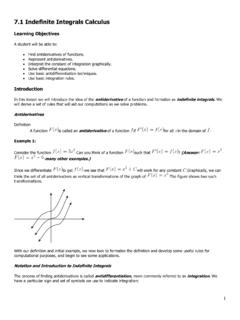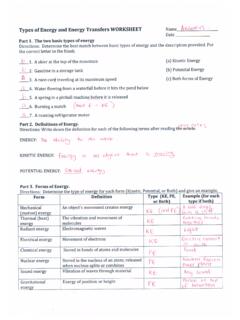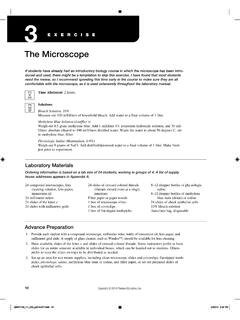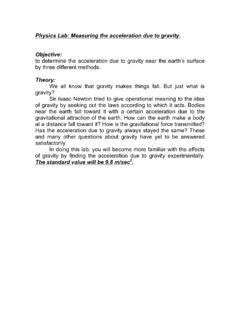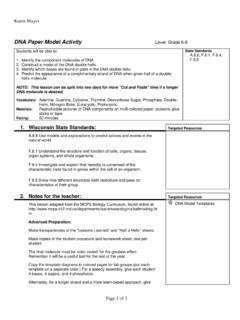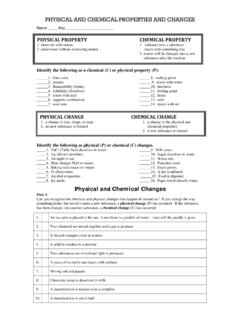Transcription of Chapter 18 Lab Dichotomous Keys
1 Name Class Date Open-Ended Inquiry Design Your Own Lab Chapter 18 Lab Dichotomous Keys Problem Big Idea A Dichotomous key is one Can you construct a Dichotomous key that could be used to way to organize and classify organisms. identify organisms? Skills Objectives Students will be able to Introduction identify an organism using a In May 2007, scientists and other volunteers gathered in Rock Dichotomous key. design a Dichotomous key. Creek Park, Washington, , to participate in a BioBlitz a quick, 24-hour survey of species living in the park. Teams worked Preparation Time 60 90 minutes if you identify in 4-hour shifts throughout the park. By the time they were done, the reference materials the teams had identified more than 650 species! Class Time Teams included experts on different types of organisms such Part A: 15 minutes as birds, beetles, fungi, and plants. The experts used identification Part B: 30 minutes; more if guides, or keys, to help them identify the organisms they found.
2 Students must find appropriate reference materials In this lab, you will first use a Dichotomous key to identify sharks. A Dichotomous key is built around pairs of statements that Group Size Part A: Individuals describe a visible trait. The reader must select the statement in Part B: Small groups each pair that best describes an organism. By following the steps Advance Preparation in the key, the reader narrows down the list of choices and finally Collect reference books and names the organism. After you have learned to use a Dichotomous photographs that illustrate key, you will design your own key for a group of organisms. a variety of groups of living organisms or identify relevant Web sites. Avoid field guides Skills Focus that contain Dichotomous keys. Observe, Classify, Compare and Contrast, Sequence Materials reference materials Build Vocabulary Build Vocabulary Students will have a more Term Definition successful lab experience if they understand these terms. dorsal On, in, or near the back or upper surface of an animal projection Something that juts out, or projects, beyond the rest of a surface identify To recognize or show to be the person or thing described; to figure out the identity of Lab Manual B Copyright Pearson Education, Inc.
3 , or its affiliates. All Rights Reserved. 109. Name Class Date Pre-Lab Questions 1. Observe Name three different physical traits that are used in the shark Dichotomous key. Answers may include the number of fins, body shape, mouth placement, and the presence or absence of spines. 2. Apply Concepts After you make a list of physical traits that you can use in your Dichotomous key, how will you decide which trait to pick for the first step? Sample answer: I will pick a trait that divides all the species into two smaller groups. Procedure Part A: Use a Dichotomous Key Before you try to identify sharks, you need to understand a bit about shark anatomy. Figure 1 is a general shark drawing with labels showing the possible locations of fins. Refer to Figure 1 as you use the Dichotomous key to identify the sharks in Figure 2. 1. Tear out the sheet with the shark drawings (pages 115 116). Choose one shark from Figure 2. 2. Read statements 1a and 1b in the key. One of the statements describes the shark; the other does not.
4 Choose the statement that describes the shark and follow the directions for that statement. 3. Continue following the steps in the key until you can identify the shark. Record the scientific and common name of the shark in the data table. 4. Repeat Steps 2 and 3 for the other sharks in Figure 2. Figure 1 General external anatomy of shark First dorsal fin Spine Second dorsal fin Mouth Anal fin Pelvic fin Pectoral fin Lab Manual B Copyright Pearson Education, Inc., or its affiliates. All Rights Reserved. 110. Name Class Date Dichotomous Key for Sharks Step Characteristic Species 1a Anal fin present .. Go to Step 2. 1b No anal fin .. Go to Step 6. 2a One dorsal fin Notorynchus cepedianus, Sevengill shark 2b Two dorsal fins .. Go to Step 3. 3a Spines on dorsal fins Heterodontus francisci, Horn shark 3b No spines on dorsal fins .. Go to Step 4. 4a Mouth at front of head Rhincodon typus, Whale shark 4b Mouth at bottom of head .. Go to Step 5. 5a Eyes on ends of hammerlike Sphyrna zygaena, projection Smooth hammerhead 5b No hammerlike head Carcharodon carcharias, Great white shark 6a Flattened body (like ray) Squatina squatina, Angel shark 6b Body not flattened.
5 Go to Step 7. 7a Long sawlike projection from snout Pristiophorus schroederi, Bahamas sawshark 7b No sawlike projection Somniosus microcephalus, Greenland shark Data Table Shark Scientific Name Common Name A Rhincodon typus Whale shark B Carcharodon carcharias Great white shark C Heterodontus francisci Horn shark D Somniosus microcephalus Greenland shark E Sphyrna zygaena Smooth hammerhead F Squatina squatina Angel shark Lab Manual B Copyright Pearson Education, Inc., or its affiliates. All Rights Reserved. 111. Name Class Date Part B: Construct a Dichotomous Key You will be working with a group of organisms such as snails, birds, antelopes, rodents, or aquarium fish. You will need to consult reference books or Web sites that include illustrations. 5. Choose a group of organisms. Then make a list of visible physical traits that vary among the species in the group. 6. Choose six or eight species from the group. On a separate sheet of paper make a simple drawing of each species.
6 Use a letter to label each drawing. Record the scientific name and common name of each species next to the appropriate letter below. A: B: C: D: E: F: G: H: Step 7 7. Use the space on page 113 to construct a Dichotomous key for Stress the need to make each pair of statements mutually your group of organisms. Use the key for sharks as a model. exclusive descriptions of only Start by choosing a trait that divides your organisms into two one trait. smaller groups. Keep dividing each of the smaller groups with pairs of statements until you have a final identifying statement for each of your species. 8. Check the usefulness of your key by making a copy of your key and asking another student to use it to identify your drawings. Lab Manual B Copyright Pearson Education, Inc., or its affiliates. All Rights Reserved. 112. Name Class Date Dichotomous Key Analyze and Conclude 1. Predict How would the Dichotomous key for sharks need to change if you wanted to use it to identify ten different sharks?
7 Sample answer: Steps would need to be added to the key to distinguish the additional sharks from the rest of the sharks. 2. Evaluate What was the most challenging part of making your own Dichotomous key? Sample answer: Figuring out the sequence of steps was the most challenging part. Lab Manual B Copyright Pearson Education, Inc., or its affiliates. All Rights Reserved. 113. Name Class Date 3. Infer Suppose you had actual samples instead of drawings. What other traits could you use to build a Dichotomous key? Answers can include any visible trait that is not captured in a line drawing, such as smell, color, or relative size of the organisms. 4. Compare and Contrast The shark Dichotomous key groups three species that lack anal fins together. But a recent cladogram of sharks indicates that the Greenland shark is actually most closely related to the Sevengill shark, which has an anal fin. What does this tell you about the difference between a Dichotomous key and a cladogram?
8 Sample answer: A Dichotomous key is a tool used to sort and identify organisms. The key does not sort organisms based on evolutionary relationships. In contrast, a cladogram organizes organisms into categories that reflect evolutionary descent. 5. Draw Conclusions In what way are the characters used to design a Dichotomous key more limited than the characters that are used to build a cladogram? Dichotomous keys use external physical characters, which can be observed easily and quickly. A cladogram can also use characters that are not easily observed, such as internal anatomy or DNA sequences. 6. Infer The Dichotomous keys in this lab are used to trace organisms to the species level. Could keys be designed which classify unknown organisms to higher levels of the Linnaean system to a family or order, for example? Why or why not? Yes. Traits can be chosen to sort organisms to any of the levels of the Linnaean taxonomic system. Build Science Skills Find a cladogram in your textbook or other reference that lists derived characters.
9 Which of the derived characters could be used as traits in a Dichotomous key? Which of the traits could not be used, and why? Students are likely to find that some, but not all, of the traits could be used in a key. Traits that are not visible or that do not lend themselves to paired statements could not be used. Lab Manual B Copyright Pearson Education, Inc., or its affiliates. All Rights Reserved. 114. Name Class Date Figure 2 Shark species A. B. C. Lab Manual B Copyright Pearson Education, Inc., or its affiliates. All Rights Reserved. 115. Name Class Date D. E. F. Lab Manual B Copyright Pearson Education, Inc., or its affiliates. All Rights Reserved. 116.









